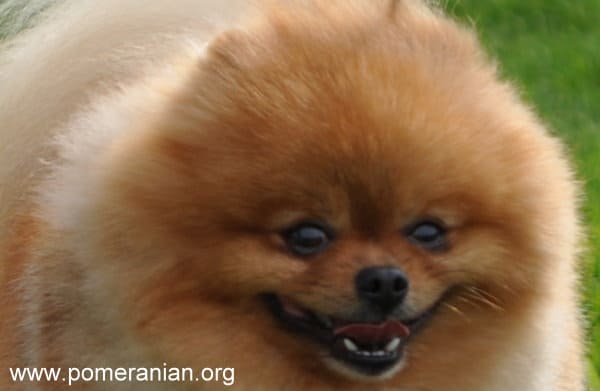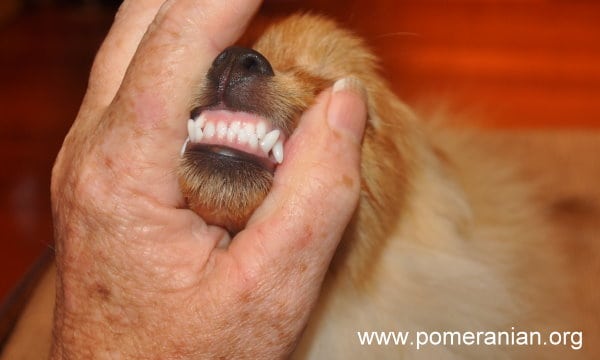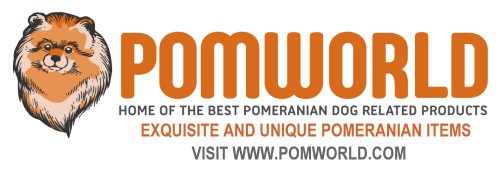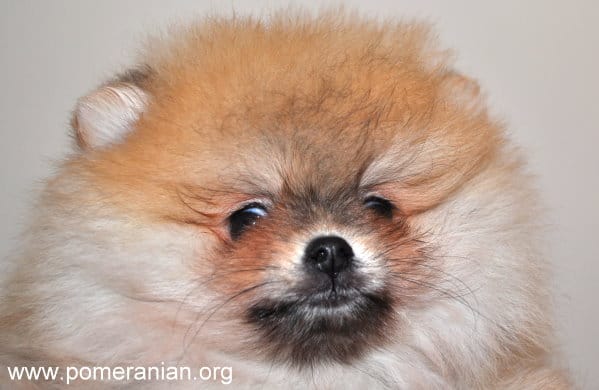Last Updated on 31/12/2020 by Dochlaggie. Post first published on October 9, 2015.
The subject of Pomeranian teeth will definitely bring out much angst among many Pom exhibitors. It is not uncommon to see a Pomeranian mature into beautiful representatives of the breed only to be kept out of the ring due to lost dentition.
The main reason our Poms lose their teeth is really due to periodontal infection. This is the region of the gums around the tooth that holds everything together.
Therefore as the gum infection progresses, the gum recedes, the periodontal ligaments supporting the teeth also loosens and the tooth gets progressively more shaky until it dislodges.
When dogs get gum diseases, it seems to deteriorate even faster than in humans, probably due to the fact that they chew relatively harder food and the ligaments are subjected to more stress.
Pomeranians as a breed tend to depend more on mouth breathing and tend to have drier mouths. This also predisposes them to gum and teeth problems as salivary flow and saliva itself has definite cleansing and protective properties as well.
Bacteria Related to Gum Diseases
Many strains of bacteria are found in these diseased gums, some of the chief culprits are strains such as Actinomycetemcomitans, P. Gingivalis etc. These strains of bacteria are mostly anaerobic, which means that they need to thrive in environments of very low oxygen content.
To eliminate these bacteria, one of the most effective way is thus to disrupt these low oxygen environment. A simple illustration of this is tooth brushing, where mechanical movement of the bristles disrupts the stagnant gum pockets.
I will list some of the common methods pom owners used to manage their poms’ teeth. I do not adopt all of them myself but will try to give my opinion on them.
Teeth Brushing

This is one of the most effective way in caring for our dog’s teeth. In brushing, the plaque is removed, giving little substrate for bacteria related to gum diseases to thrive on. However this has to be done on almost daily or two days frequency to be most effective.
This is because plaque builds up within a day, hardens in 2 days, after which it will be difficult to remove. This requirement of diligence on the owner’s part often presents some problems, especially for owners or breeders with large number of dogs.
Toothpaste is often used with brushing. The composition of toothpaste varies greatly. In different way most of these components do contribute towards greater effectiveness of brushing. In humans, we know toothpaste in general help us clean teeth up to 30% more effectively.
However the owner should still be mindful not to use excessive amounts as the main beneficial component in brushing is still the mechanical removal of plaque.
Oral Rinse or Swab
The most effective mouthwash to date for gum diseases would have to be chlorhexidine. It is most effective at 1.5- 2% concentration. However it is often only available at 1% concentration at drugstores. This is because at 2% it is very bitter, stains teeth quickly, and with long term use may affect taste buds on the tongue.
I know that my poms hate the taste of it, at even 1%, so it gets doubly difficult to clean their teeth or swab their mouths, even with the most cooperative poms.
Some breeders I know use hydrogen peroxide as a swab. Hydrogen peroxide is a very strong oxidant. It works by oxidising the area, eliminating these anaerobic bacteria. Because of its strong oxidsing characteristics, peroxide is also a teeth whitener.
You will probably have found that peroxide can make your pom’s teeth nice and white, but you have to be careful because if there is a cavity in the teeth that you have not noticed, it can enlarge the cavity significantly, to the extent of hurting the pulp.
In high concentrations, peroxide can also damage the periodontal ligaments as well as be toxic. If your pom has receded gums and roots of the teeth exposed, they can also be demineralised by the harsh action of peroxide.
Water Additives
I have seen a number of water additives at pet stores, which claim to protect gums and teeth and reduce foul odours. Many of these carry active ingredients which are also found in pet toothpaste, namely, bicarbonate, enzymes such as amylases, chlorophyll etc.
I have not personally found them effective, probably because my poms do not seem to agree with the taste of water with such additives and seemed to reduce their water intake.
While I agree that many of the active ingredients do work from a theoretical perspective, I feel that with such a mode of delivery, ie drinking water, the contact time is too short to allow them to be truly effective. Presence of plaque on the teeth may also impede their action.
Bone Chewing
The common knowledge is that chewing on bones help keep their teeth clean. This is because the tough chewing actions breaks up the hardened built up of plaque. It also stimulates saliva flow which is beneficial.
I do give my poms bones from time to time but care should be exercised because of the fine teeth that many of our show poms have, which are at risk of fracture with bone chewing. Suitable bones must be selected and they must also be supervised to make sure they do not choke.
I personally do not like to feed raw hide because they soften with chewing and I am concerned that a chunk may come off and cause the pom to choke. Nevertheless I suppose with careful supervision they work fine too.
I have found the Nylabone brand of chews quite useful, especially the one with little ribs. However not every of my poms seem to enjoy chewing a piece of rubber as much as they do with a real bone.
Vet Visit
Despite all our efforts to upkeep our poms teeth, it is not uncommon to pull back the cheek and notice a fair amount of tartar which have built up on the teeth without our notice. At such occasions it may be necessary for a dental scaling visit at the vets.
The poms are often put under general aneasthesia and subjected to manual or ultasonic scaling to remove their tartar. I personally do not fancy the idea of putting poms under general anaesthesia but I do acknowledge that there are many times when such visits are necessary.
It is important to start scaling visits even before the teeth starts to become shaky, This is because once teeth mobility is detected, it is usually hard for the teeth to be firm again, even with subsequent care and elimination of active gum disease.
Vaccines
Pfizer released a vaccine (for selective dog use only) for gum disease. This product was discontinued after a four year study and the conclusion that the vaccine was ineffective in reducing canine periodontal disease.
Scientists have been talking about a parallel for human use for years but there does not seem to have any progress to date. My personal guess is that perhaps too many strains of bacteria are involved to have a truly effective vaccine
Finally I wish everyone success with managing their poms’ teeth. It is a common problem area, but compared to many other problems, eg skin disease, testicles, patellas, it seem to be a more preventable disease with good care.
Thanks to Dr Peter Chow for this informative and very helpful article. Dr Peter Chow, a Singaporean based Dentist, is also a Pomeranian breeder and exhibitor.
Copyright Dr Peter Chow. All rights Reserved.










